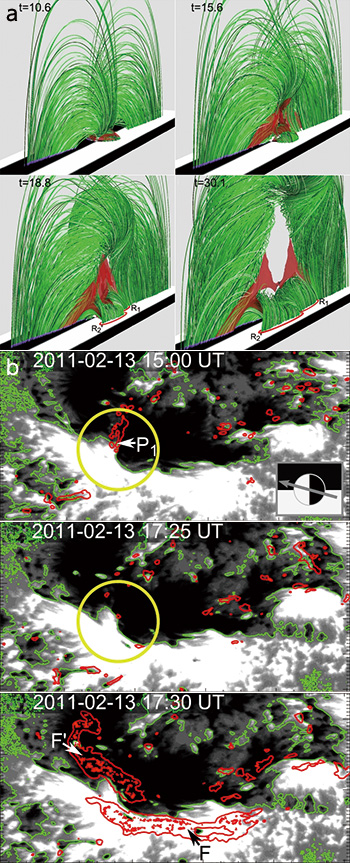TOP > Report & Column > The Forefront of Space Science > 2013 > Advancement of Solar Research by HINODE Satellite
![]()

Elucidation of magnetic structure evolution causing flares HINODEís precise vector magnetic-field measurement of the solar surface also brings great advances to research on the trigger process for solar flares, their timing and scale. The solar flare is the largest explosive event of the solar system, scattering electromagnetic waves from radio wave to gamma ray, charged particles, and neutrons to the solar system. It sometimes even makes an impact on our daily lives such as causing satellite malfunction. Unless we understand accurately the factors that decide the frequency and scale of flares, we cannot forecast their occurrence. In order to elucidate the trigger process of flares, a large-scale computer simulation was performed using the supercomputer ďEarth Simulator.ĀEThe simulation yielded findings such as: the scale of flares varies depending on the relation between the direction of the magnetic fields ascending from the sunís interior to the surface and the direction of the magnetic fields originally present above the surface; and flares can be classified into two types. We also confirmed that SOTís observation of the relation between the internal/surface magnetic fields and flares supported the simulation result (Fig. 2). These results are paving the way for us to predict the occurrence of flares. Specifically, they provide clues as to what we should look for in vector magnetic-field observation in an active region to forecast the occurrence and scale of flares to follow. 
In addition, research is advancing to reproduce the release of plasma clouds, propagation of shock waves, and flare-loop structure in flares observed by XRT. This reproduction can be performed by numerical simulation, which obtains the structure and temporal evolution of the magnetic field in the corona by using SOT vector magnetic-field data as a boundary condition. Research merging high-accuracy observation data retrieved by HINODE and numerical simulations is a new trend realized by HINODE. Solar activity has been gradually increasing since around 2011 and it is anticipated that flares will continue to occur frequently in the next three years or so. With HINODEís flare observations during this period, it is expected that there will be further advances in the elucidation of the trigger mechanisms and occurrence of flares.
|
||||||




